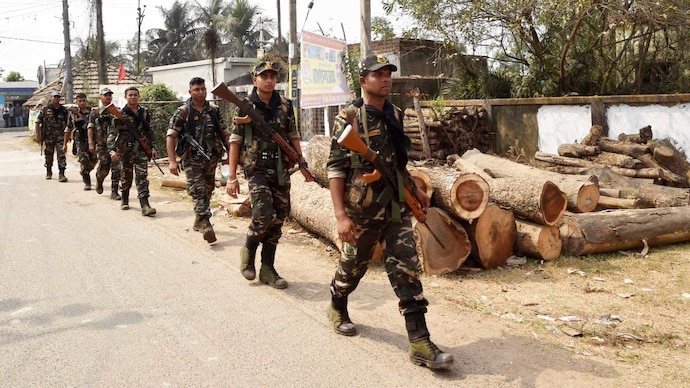Why elections in West Bengal are invariably violent | India Today Insight
The first phase of voting on March 27 saw sporadic violence, though determined voters came out in large numbers to cast their franchise

 Barely an hour in the first phase of polling in West Bengal had passed on March 27 when police recovered the blood-spattered body of a BJP worker in Salboni in West Midnapore, underlining how elections and violence were inseparable in the state.
Barely an hour in the first phase of polling in West Bengal had passed on March 27 when police recovered the blood-spattered body of a BJP worker in Salboni in West Midnapore, underlining how elections and violence were inseparable in the state.
Forty-eight hours before Bengal went to polls in 30 of the 294 assembly seats, spread over the districts of Purulia, Bankura, Jhargram, East Midnapore and West Midnapore, two BJP workers were found dead under mysterious circumstances and bomb blasts had rocked Trinamool Congress (TMC) offices in Joynagar and Bankura, leaving four people severely injured.
It needed no guessing how polling day would unfold. To check violence and ensure heavy security with the help of central forces in all sensitive booths, the Election Commission (EC) had spread out the Bengal assembly election schedule over eight phases, from March 27 to April 29. Perhaps never before has the state seen such an extended polling schedule.
The Centre has stationed 944 companies of the Central Reserve Police Force (CRPF), the highest election deployment in the state yet. A fortnight before the March 27 voting, around 400 companies were assigned area domination and patrolling duties. But violence still could not be checked. Attacks, arson, hurling of bombs and vandalism went on unabated as the ruling TMC and its principal challenger, the BJP, slugged it out.
In North Dinajpur district, the house of a BJP leader who had defected from the TMC was gutted while a young leader of the Bharatiya Janata Yuva Morcha (BJYM) was attacked with sharp weapons in Siliguri. A former TMC MLA was heckled and his car damaged in North Bengal. These were among the incidents witnessed in the run-up to the first phase of voting.
Even though party leaders and workers condemned the violence in public, many appeared to maintain a different stand in private. “It had to be tit for tat. You cannot play good when you have to deal with heinous criminals and murderers. A party leader has instructed us to defend ourselves and go for the offensive if required,” claimed a BJP leader from Diamond Harbour in South 24 Parganas, on condition of anonymity.
It was in Diamond Harbour that BJP national president J.P. Nadda’s convoy had come under attack in December while he was on way to attend a rally. Violence begets violence and the vicious cycle goes on in the absence of political will to break it. “I don’t see the cult of political violence ever coming to an end in Bengal. It is a way of impressing upon the voter the political clout you hold, the area you dominate and the power you wield. It’s also a way to keep the opposing forces under check,” says poll analyst and psephologist Biswanath Chakraborty of Rabindra Bharati University.
The Left Front, which ruled Bengal for 34 years before being routed in 2011, was accused by rivals of various electoral malpractices, including manipulating the voters’ list. It is alleged that voters opposed to the Left ideology would invariably be subjected to fear psychosis, with hooligans entering villages and threatening to send bales of white cloth (widow’s attire) to households that voted against the Left. Murders and crude bomb attacks were common.
The TMC is accused by its rivals of scaling up the violence to new heights. Instead of tampering with the voters’ lists, its goons allegedly scared away voters of rival parties and even forced rival candidates to withdraw from the fray. In the 2018 panchayat polls, the TMC won 34 per cent of its seats uncontested.
According to Chakraborty, compared to past years, the first phase of polling on March 27 was by and large incident-free, except for sporadic violence. A Left Front heavyweight was heckled and his securitymen attacked in Salboni. The windshield of the car of BJP leader Suvendu Adhikari’s brother Soumendu was damaged and his driver attacked. Sujoy Bandyopadhyay, the TMC candidate from Purulia, was caught by TV cameras purportedly shouting that he will shoot them (BJP hooligans). “If a candidate can stoop to issuing threats in public right in front of CRPF personnel, it doesn’t need to be told what’s going on,” says Mainak Maity, a voter in Kanthi South, which went to polls in the first phase.
But according to Chakraborty, the electoral malpractices weren’t one-sided. “Both the BJP and the Trinamool played it their own way, depending on their might, which is why unlike other times, both parties were thronging the EC office with complaints against one another,” he says added.
The positive takeaway from the first phase was that people, particularly women, came out in large numbers to vote—a turnout of 79.79 per cent. Chakraborty, however, says: “A huge turnout does not necessarily mean it’s a vote against the incumbent party. At least, that has not been the case in Bengal. We saw a huge turnout in 2006 but it was a mandate for a second term for Left leader Buddhadeb Bhattacharjee. Even in 2016, the high polling percentage had gone in Mamata Banerjee’s favour.”
But BJP leaders are upbeat. They see it as a vote for ‘ashol poribortan (real change)’ that PM Narendra Modi has promised the state. “People are voting fearlessly to oust the corrupt and anarchic Trinamool Congress. We have lost 130 people in our fight against the Trinamool. They are baying for more blood, but we are a difficult breed to be cowed down,” says BJP vice-president Joy Prakash Majumdar.
Read India Today magazine by downloading the latest issue: https://www.indiatoday.com/emag
